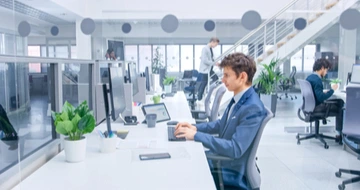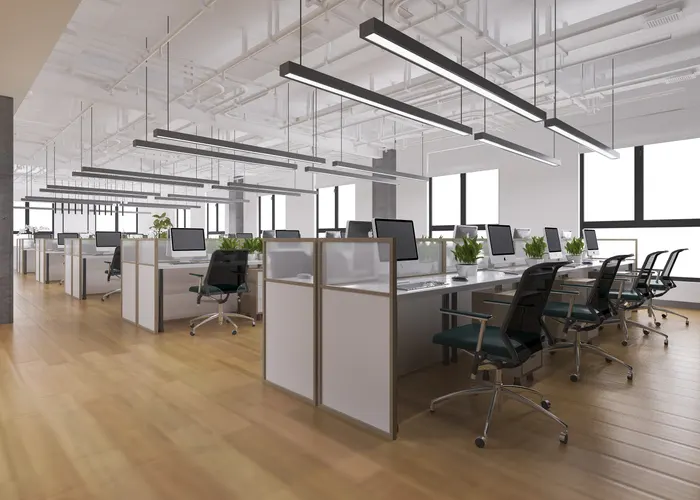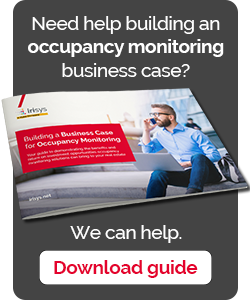5 pieces of data space utilization dashboards can give you
Getting the most out of your office space has never been more important, especially as remote and hybrid working becomes increasingly prevalent. In fact, nearly 70% of employees are working from home at least once a week.
Space utilization—the practice of getting the most from your office layout and maximizing efficiency—depends on having access to real-time and accurate data.
Space utilization dashboards deliver invaluable insights into how your office space is being used, helping facilities managers to track key metric data and identify optimization potential.
Let’s take a closer look at five key pieces of data space utilization dashboards can provide.
Data in real-time
Occupancy monitoring solutions, such as True Occupancy, deliver data in real-time. The advantage of this is that action can be taken immediately when it’s required. For example, an occupancy solution that’s integrated with a building’s management system could turn off lighting and HVAC in a meeting room when it becomes empty.
Another example of how this real-time data can be of use to organizations is in regards to hygiene, a massive issue for facilities managers as employees return to the workplace. Cleaning schedules can be altered on-the-fly based on room usage, with cleaners directed to recently vacated rooms or desks, rather than sticking to set routines regardless of whether the space is dirty or has actually been used.
Occupancy sensors can also report on how your organization is performing in terms of maintaining social distancing. For example, data on room occupancy can show where set limits are being exceeded. Important for complying with any local restrictions as well as ensuring that employees feel safe and comfortable when they return to the workplace post-pandemic.
Access historic occupancy data
Real-time data is hugely valuable for making instant decisions when needed, but historic occupancy data that demonstrate trends and patterns is what will allow you to optimize the workplace over the long term.
Let’s consider an example.
Your organization’s employees work from two main office spaces: Office A and Office B. Both offices average 50-60% occupancy, but Office B frequently peaks at 100-110% occupancy, while Office A only peaks at 70-80%. Armed with this data, you can now investigate why this might be the case. Perhaps the WiFi single in A isn’t strong enough, or the working environment isn’t as comfortable. Once the cause is identified, you can work to redress the balance and ensure that Office B isn’t becoming overcrowded and endangering employee safety.
Note that the True Occupancy solution uses advanced AI to minimize and correct errors with ‘patented end of day error correction’ functionality, so you can always rely on the data you’re accessing.
Desk utilization
Hot Desking is increasingly common—particularly under hybrid working scenarios. After all, it doesn’t make sense to reserve a space for an employee that is only in the office twice a week.
This, of course, poses a challenge: what if you don’t have enough desks for everyone on the most popular in-office days? Alternatively, what if you have more desks than are required at even the busiest of times?
Occupancy sensors provide you with this information. Not only will they allow you to optimize the number of workstations, but they can also be integrated with desk booking systems that show employees when and where workstations are available to use.
Conference room utilization
The Covid-19 pandemic hasn’t just changed our attitudes to working remotely—it’s also made us think about meeting length and efficiency. This is another area where occupancy sensors provide insight.
Meeting room ‘rightsizing’ is key to office space optimization. Do you have the right number of meeting rooms? Are they being used effectively, or do they sit empty for days on end? Perhaps meeting rooms intended for eight people are being occupied by a single person, suggesting you don’t have enough smaller rooms available.
Conference and meeting rooms are often one of the biggest culprits when it comes to office space not being used effectively. The shift to hybrid working will only exaggerate this as more meetings become hybrid themselves, with only some participants in the office and the rest joining remotely.
Utilization Zones
As well as conference and meeting rooms, True Occupancy can provide data on the utilization of every area, or ‘zone,’ of the office. This includes break rooms, canteens, or other communal areas.
Not only does this give facilities managers the opportunity to see where space is being under or overutilized, but this data can also be shared with employees. For example, if employees can see when the canteen is busier, they can choose to go at quieter times, increasing their satisfaction, well-being, and productivity.
Conclusion
Do you want to understand more about the benefits of space utilization dashboards, and how occupancy sensors can help your organization calculate space utilization rate? Get in touch with our experts for a free demo of the True Occupancy solution.
Share this
You May Also Like
These Related Posts

Why is space utilization important and what is the relationship with space occupancy?

Why is Space Management Important for an Office?

How To Calculate And Optimize Your Office Space Utilization Rate
Connect with us
Need more information? Ready to get started? We're here to help, get in touch.


